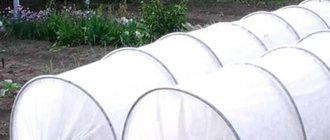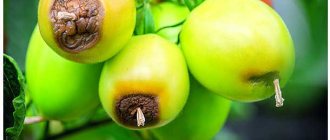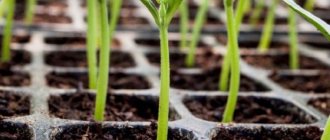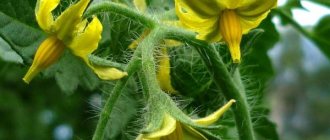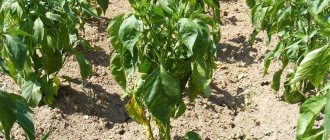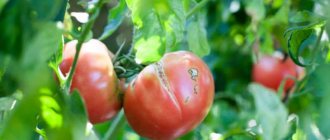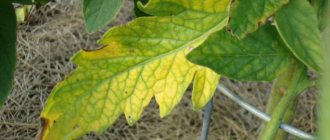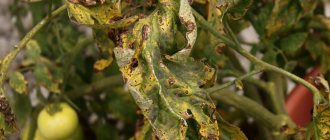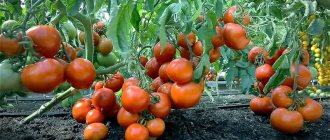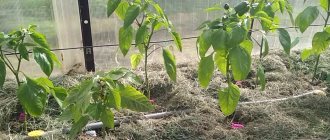For what reason can the tops of tomatoes begin to wilt and dry out, with or (less commonly) without curling of the leaves? This may surprise you, but the list of reasons is quite wide – from violation of agricultural practices to infection with dangerous diseases.
Plant wilting is currently a multi-valued term. This is the familiar loss of turgor, and the pathological rigidity of the non-woody parts of the plant. Experienced gardeners are also familiar with the concept of “withering” in the context of some dangerous crop diseases.
From all this, it seems logical to conclude that cultivated plants, including tomatoes, can wither for both natural (underwatering, overheating in the sun, pinching) and pathological (development of infections) reasons. But in all of these cases, the key word is withering. Let's take a closer look at the factors that could provoke it.
I know why the tops of tomatoes wilt.
Here, in the Eastern Orenburg region, the heat began, which affected the development of tomatoes.
I began to notice that the tops of the plants were withering, the tomato leaves were turning into a “rag”. I figure out the problem and find an excellent supplement. What happens to tomatoes: during the day, in the heat, the upper leaves become limp, despite the fact that the soil under the mulch is moist. It turns out that the plant, besides moisture, is missing something.
Causes of leaf wilting.
First reason
is that the plant’s root system is not in order. Maybe root rot, or maybe pests damaged the root system.
In this case, the most effective way is to water with succinic acid.
For 10 liters of water, 2-5 g. succinic acid. First, we dilute it in hot water; in cold water, succinic acid does not dilute well.
I watered it, and 3 days later I did a second watering. Stimulated the root system, many young roots appeared on it, and began to work intensively, supplying the plant with water and mineral nutrition.
After a week, the top of the plant should return to normal, but it happens that succinic acid did not help.
The second reason
The point is that during the period when the plant began to lay the first clusters, we stop observing the development of the plant as a whole. Even at that time, the top of the tomatoes should have already attracted our attention. It becomes thin and the leaves are straight, then you need to fertilize.
For 10 liters of water - 10 g. calcium nitrate and 10 g. ammonium nitrate. Water at the roots.
Why is it important to fertilize with two nitrates? The fact is that calcium nitrate is necessary for the plant throughout the entire growing season, but it contains practically no nitrogen. There is twice as much nitrogen in ammonium nitrate, and it is nitrogen that will give impetus to the development of green mass of plants.
As a result of using this composition, the top of the plant thickens and the leaves become straight during the day, and in the evenings they begin to curl a little.
This year I solved the problem using the first method, using succinic acid.
Perhaps you have other ways, write, I think it will be interesting not only for me, but also for all the readers, of whom there are more and more. I'm very glad to read you all. Join us too!
LIKE, REPOST AND SUBSCRIBE ARE WELCOME. SUBSCRIBE.
If it is more convenient for you to read and watch my articles on social networks, you are welcome to the pages:
VKontakte , Youtube, Odnoklassniki
I also recommend you my other articles:
Source of the article: https://zen.yandex.ru/media/id/5c061eebaff29f03eac88395/ia-znaiu-pochemu-vianet-verhushka-tomatov-5cf913e0c0dc5700afbbac20
Improper feeding of plants
Agronomists argue that the organization of the fertilizing process seriously affects the development of many crops. Moreover, not only a low amount of nutrients will be harmful, but also their excess.
To determine exactly what substances tomatoes lack, you should look at exactly which parts of the plant are wilting. In the case when old leaves turn yellow, fertilizing with zinc, magnesium and molybdenum should be organized.
Many people are interested in why the tops of tomatoes wither and what fertilizers should be applied. In this case, the plant lacks one of the following elements:
- manganese;
- chlorine;
- boron;
- calcium;
- iron;
- sulfur.
It is enough to add those substances that are deficient in order to resume normal growth of tomatoes.
What to do if the tops of tomatoes in the greenhouse wither
Surely every gardener has had to deal with wilting of the tops of greenhouse tomatoes. Every time, before taking any measures, you need to understand the reason for this behavior or at least eliminate the worst options:
Read on dacha6.ru:
- First of all, check whether the inexplicable wilting and yellowing of the leaves is not a consequence of the development of a dangerous disease: late blight, mosaic, verticillium, fusarium wilt, bacterial mottling, bacterial wilt, necrosis, blackleg, rot. You can read about each of the listed diseases and measures to combat them here.
- Next, you should check the plants for pests. I recommend digging up 1 heavily damaged plant that is lagging in development and carefully inspecting the roots for the presence of wireworms , May beetle larvae and characteristic damage from the activities of these pests. Spider mites can also pose some danger.
- So, diseases and pests were not confirmed. This is already good - there is no infection in your greenhouse. Now we need to deal with the watering situation. It is important to note here that wilting can be caused not only by a systematic lack of moisture, but also, more likely, by excessively abundant watering. Mulching the surface layer (not earlier than June, when the soil has warmed up well!) and moderate watering will help normalize the situation. Moisture will be retained longer under natural flooring. If you rarely visit your dacha (once a week), mulch is required (straw, hay). To water tomatoes, use warm, settled water from a barrel. Perform the procedure in the evening to prevent sunburn on the leaves. After the event, ventilate the greenhouse.
- Young tops of tomatoes can wilt in the heat of the day. This banal reason should also not be discounted.
- Slight drying of the tops may be a consequence of a systematic lack of boron. In this situation, adding a weak solution of boric acid will help reverse the situation.
- The consequence of point 3 and premature mulching is that the discrepancy between the soil and air temperatures leads to dehydration of the upper parts of the plants. The ground is cold and the air is hot. As a result, the root system develops more slowly (lags behind) and cannot fully provide the entire leaf apparatus with moisture and nutrients.
Causes of the disease in open ground
Among the main factors for wilting of the tops of tomatoes in a greenhouse and open areas are non-compliance with the conditions for growth and fruiting, and improper cultivation. Tomatoes do not tolerate lack of light, excessive or insufficient watering. The condition of the shoots is negatively affected by:
- excess nitrogen in fertilizers;
- temperature exceeding 30 degrees;
- increased humidity – more than 60%.
The bushes are restored as new roots grow. To stimulate the process and improve the health of young plants, agronomists advise using for irrigation:
The problem of wilting of apical shoots arises due to several factors.
Improper watering
If tomatoes dry out on top, first of all pay attention to watering. Bushes suffer from both water deficiency and excess supply.
Lack of light
Tomatoes feel a lack of sun quite quickly. For seedlings, the duration of daylight is at least 12-14 hours. Phytolamps are used to prolong lighting.
Overheat
Heat above 28 -30 degrees has a negative effect on the bushes. The tops of the trees are the first to wither. Ventilation is carried out in greenhouses.
Diseases
In open ground they occur due to the fact that pathogens of fungal infections lead to wilting of plants. Often the process begins with the upper shoots and leaves. What diseases are accompanied by damage to the tops and wilting:
- Fusarium . Tomatoes are affected in open beds, but outbreaks also occur in greenhouse conditions. Spores persist in seeds or soil for several years.
- Late blight . Typical signs are brownish spots on leaf blades and fruits. Withering accompanies illness. Whitish plaques may appear on the lower leaves.
- Verticillium wilt . Fungi infect actively flowering tomatoes. Characteristic yellowish or white spots appear. Tomatoes dry out quickly after evening watering in the morning due to occlusion of the vascular bundle. For control, disinfection and spraying with fungicides are used.
Acute moisture deficiency
A common reason why the leaves of tomato seedlings curl up in a boat is a lack of moisture. It is recommended to water tomatoes abundantly and regularly, without long breaks.
A high need for moisture in tomatoes occurs after planting seedlings in garden beds or in a greenhouse. At this point, it is advisable to pour 4 liters of liquid onto each bush. After waiting 10 days, it is recommended to re-water, increasing the watering rate by 50%.
The following is based on the weather:
- if it’s hot and the tomatoes are slightly wilted, you need to water them twice a week;
- in cool weather, 1 irrigation per week is sufficient.
When the ovaries begin to form, the watering rate is increased by 1/3.
Experiencing a moisture deficit, the tomato begins to reduce the proportion of evaporated moisture and the leaves of the plant curl inward. Having noticed this, you should immediately start watering.
Photo. Tomatoes suffering from moisture deficiency
What to do and how to treat?
- on the characteristics of the variety;
- humidity in the garden;
- weather conditions.
They try to maintain the temperature within comfortable limits for tomatoes:
- during the day it is 22-28 degrees;
- at night not lower than 16-17 degrees.
What to do if infected with pathogens? For fungal infections in the initial stages, the following is used to irrigate bushes:
- 1% Bordeaux mixture;
- copper sulfate;
- other copper preparations.
For late blight, the use of Fundazol and Fitosporin gives a quick effective effect. To combat the fungus, systemic fungicides are used:
Prevention of wilting
Preventive measures:
- Plant healthy, strong bushes.
- Seeds are disinfected with 1% potassium permanganate.
- The soil is pre-fertilized.
- Place a handful of dried nettles at the bottom of the hole.
- Keep a distance taking into account the tallness of the variety.
- Autumn green manure is planted - a combination of legumes and grain crops.
- The greenhouse is fumigated with sulfur for disinfection.
- The beds are shed with a 1% solution of potassium permanganate.
Source of the article: https://repka.online/ovoshhi/tomaty/vyirashhivanie/uvyadanie-verhushek.html
How to recognize the problem
Often tomatoes planted in a polycarbonate greenhouse begin to wilt, especially the tops. We must immediately find out the cause of this problem and begin to eliminate it. Perhaps this is a fungal disease - fusarium.
If it is hot outside, then this fungus begins to actively develop. It first attacks the lower parts of plants. The annoying thing is that it can only be detected when the tomatoes begin to bloom.
- The lowest leaves turn pale, then the veins lighten;
- The leaf petioles begin to deform;
- The leaves gradually curl and then fall off;
- The shoots begin to wither, the roots die, and the plant disappears.
If you have already encountered this problem, then you need to protect tomatoes from fungus from the seeds. Before planting, 2 weeks before sowing, they should be sprayed with a solution of Fundazol or Benazol. It is recommended to treat the soil for seedlings with copper sulfate: 70 g of the substance is required for 10 liters of water. Adding dolomite flour or chalk to the soil will help. This fungus does not withstand such soil treatment.
Before planting seedlings in a permanent place, their roots must be treated with a fungicide solution, dipping them into the solution.
If signs of the disease appear on bushes with color, then when the first signs of the disease appear, treat the bushes with any fungicide, adding potassium permanganate to the solution.
Particular attention should be paid to moistening the beds. If the upper brushes droop, then moisture does not reach them. Insufficient water supply causes soil cracking. And this leads to damage to the root system, resulting in developmental delays.
Gardeners must follow the rules for watering in a greenhouse:
- Water once every 7 days;
- After watering, be sure to cover the soil with a layer of mulch and constantly loosen it. The soil should be loose and moist, but not wet;
- At the stage of flowering and the first ovaries, plants should be fed with complex fertilizer.
If tomatoes become sick, immediately treat them with a solution of Khoma, Ridomil or Fundazol. The wilting of shoots will help prevent the addition of potassium-phosphorus compounds, as well as succinic acid: 1 sachet per bucket of water.
The soil
Tomatoes love loose and nutritious soil. The best option would be soil made from equal parts of sand, leaf humus and clay. Peat will add looseness to the soil; do not forget to add organic fertilizers. Soil acidity should not exceed 6.5 pH. Before planting, the entire bed is watered with a solution of copper sulfate, which kills harmful microbes. To do this, dissolve 80 grams of copper sulfate in a ten-liter bucket of water.
How to prevent leaf curl
Very often, tomato leaves curl. In hot weather they have little moisture, and curled leaves evaporate less. To fix this, you need to water it properly. There is no need to pour all the water under the bush at once. It is necessary to water in two steps. First pour about 2 liters, and then another 3 liters.
Advice: there is no need to water frequently; it is better to loosen and cover with mulch to prevent the soil from drying out.
Why else can leaves curl?
- If unrotted manure was introduced, then the root system is inhibited. The leaves begin to curl and the bush withers.
- Insufficient feeding can also cause wilting. Do not get carried away with nitrogen fertilizers, otherwise the tomatoes will begin to fatten.
- If all the plantings began to die, then they were affected by late blight. If a disease is noticed, it must be treated immediately.
- The greenhouse must be ventilated. And also make sure that the tomatoes are not eaten by aphids and whiteflies.
- You should not pick off many shoots and leaves at one time. The plant will be sick.
Violation of pinching technology
The leaves at the top of the bush and in its central part curl due to improper execution of the pinching procedure. Stepchildren grow from each leaf axil; they should be removed by breaking them off at a length of 5 cm. When the formation of bushes is delayed and the stepsons are broken out late, leaf curling begins.
Important! If overgrown stepsons have been removed and the tomato leaves have curled, you should spray the bushes with Zircon.
Advice from experienced gardeners
If the soil is moist, watering is correct, but the tops still wither, then succinic acid will help again. First dissolve the acid packet in hot water, then pour it into a bucket and pour over the tomatoes. After 3 days, you can repeat the same watering.
If this does not help, then the tomatoes should be fed with the following composition: 10 g of calcium nitrate and 10 g of ammonium nitrate should be diluted in a bucket of water. Pour from 0.5 to 1 liter at the root, depending on the growth of the seedlings.
This fertilizer will help make the stem thicker, increase the green mass so that the upper ovaries begin to form.
What to feed when flowers fall
If tomatoes are just blooming, but the fruits are not set, or even worse, they begin to fall off, what should you do? It is necessary to create optimal conditions. The greenhouse should have moderate humidity, good ventilation, adequate nutrition, and a temperature not lower than plus 15 degrees.
If it is impossible to create such conditions, then boric acid can save flowers from falling: 5 g per 10 liters of water. This solution must be watered or sprayed.
In order for the fruit to set better, it is necessary to spray the brushes with Betaxon. Dilute 1 ml of Betaxon (not more) in 1 liter of water, pour into a spray bottle:
- Put a rubber glove on your left hand to protect the leaves from getting the drug.
- Hold the tomato brush by your hand, spray the solution once, but not 2 or 3 times, but only once.
- Take another brush, spray the solution and go around all the brushes.
This treatment will help set fruit from each flower on the tassel.
Therapeutic activities in the greenhouse
If you notice signs of disease on tomatoes (spots on foliage, curling and lethargy of leaves, rotting fruits). Diseases can be treated with biofungicides (Fitosporin, Baktofit, Planriz, Alirin), as well as drugs with an immunostimulating effect (Previkur Energy). Treatments are carried out 2-4 times, with an interval of 1-2 weeks.
There are also folk remedies that have shown their effectiveness in practice. There is such a medicine as Trichopolum (1 tablet, 1 liter of water). Spraying is carried out once every 1-2 weeks.
- The safest is the whey that remains after making cottage cheese, but you can use kefir. Dilute kefir with water 1:1 and spray 1-2 times a week.
- To prevent and get rid of fungal diseases, iodine will help: 1 drop per 3 liters. water.
- If tomatoes are affected by diseases, prepare an infusion (a bucket of water + 100 g of yeast), process 3 times per season.
- Potassium permanganate: 1g per 10 liters of water. Treatment is carried out 1-2 times a week, at least 3-4 times.
- If tomato flowers fall off, boric acid will help: 1 tsp. Dilute boric acid in 10 liters of hot water, then cool. At the same time, it is protection against diseases and excellent nutrition.
Finally: if the tops of tomatoes in the greenhouse are wilting, use proven means to save the crop.
Source of the article: https://anisima.ru/vyanut-verhushki-tomatov-v-teplitse-chto-predprinyat/
Insect pests
In addition to fungi and viruses, insects can also infect tomatoes. They are dangerous because they leave bites on the stems and leaf blades, through which microorganisms then penetrate, leading the crop to death.
- Aphids are small pests that feed on tomato juice and leave behind a sticky secretion. It multiplies very quickly. You can get rid of it using folk remedies or insecticides.
- Whitefly - This small butterfly with white wings feeds and reproduces on the underside of crop leaves. She draws all the juices out of them, after which the tomatoes die. You can get rid of it with the help of the drugs “Fitoverm”, “Aktara”.
- Spider mite - its appearance is indicated by cobwebs on the stems. He spoils the greens by making punctures in them, after which they die. You can get rid of ticks using acaricides.
It is easier to prevent their appearance, so it is recommended to inspect the bushes regularly; when pests first appear, you need to take the first protective measures. This is the only way to save the future harvest.
